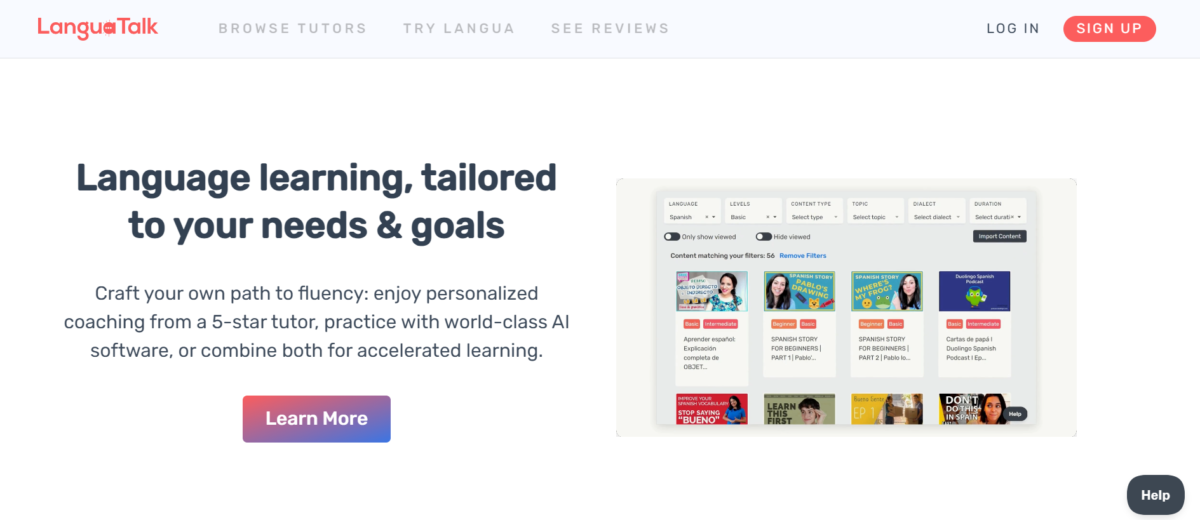Learning a new language can easily be overwhelming. Between memorizing vocabulary, grasping tricky grammar rules, and practicing pronunciation, it’s no wonder many give up before getting started.
Duolingo, however, offers a refreshing alternative! Unlike traditional methods that rely on textbooks and rigid classroom settings, Duolingo is free, accessible, and gamified. It feels much less like a chore and more like a fun challenge. It’s the most popular language-learning app, boasting over 575 million active daily users.
When my parents bought a home in Panama, my Mom decided it was time to brush up on her Spanish. She turned to Duolingo and has been at it for a few years. It’s been fun watching her progress! Her confidence has grown so much that she can speak with locals effortlessly.
But how effective is Duolingo in helping people become fluent in foreign languages? How does it compare to traditional methods and top alternatives?
In this Duolingo review, I’ll discuss its pros and cons, what it is, who it’s best for, and its key features. Then, I’ll show you how I started using Duolingo to learn Spanish myself!
I’ll finish the article by comparing Duolingo with traditional methods and my top three alternatives (Babbel, Pronounce, and Langua). By the end, you’ll know if Duolingo is right for you!
Verdict
Duolingo is a free, gamified platform that offers over 40 languages and effectively builds foundational vocabulary and grammar skills for beginners. However, it focuses mainly on simple grammar and lacks real-world practice. Therefore, achieving complete language fluency requires supplementing it with other methods like conversation practice and immersion.
Pros and Cons
- A free app that’s accessible on desktop or mobile.
- Gamified elements boost motivation.
- Short, bite-sized lessons fit busy schedules.
- Personalized practice adapts to your pace.
- Offers 40+ languages.
- Incorporates features like speech recognition and personalized stories.
- Easy-to-use design with levels and rewards.
- Supports diverse learners and connects cultures.
- Effectively builds foundational vocabulary and grammar skills for beginners.
- Focuses mainly on vocabulary and simple grammar.
- Lacks real-world practice opportunities.
- No interaction with native speakers.
- Some phrases are not helpful in daily conversation.
- Requires supplementing with other methods for comprehensive learning.
What is Duolingo?
Launched in 2012, Duolingo is a language learning platform created by Luis von Ahn and Severin Hacker at Carnegie Mellon University. Their goal was to make language learning free and fun for everyone!
The platform offers courses in over 40 languages, from widely spoken languages like English, Spanish, and French to less commonly studied languages such as Welsh and Navajo. It’s also available on mobile and desktop devices, making it easily accessible to anyone worldwide.
With over 100 million monthly active users, Duolingo is the most popular language-learning app globally. Its users complete billions of translation exercises weekly, reflecting its effectiveness in engaging learners and promoting consistent practice.
App Overview
In a nutshell, Duolingo works by having you play games to learn a new language. Its gamified approach to learning includes interactive lessons that use spaced repetition to enhance retention and motivation through points and rewards.
That’s the genius of Duolingo’s gamified approach: they’ve turned what could easily be boring (learning a new language) into something addictive!
With Duolingo’s bite-sized lessons, picking up a new language is easy. You start with basic stuff like “el gato” (the cat) and “la manzana” (the apple), and before you know it, you’re stringing together whole sentences!
Course Structure & Lesson Format
The course is well structured, too. Duolingo has these skill trees that are like a video game level map. Each branch focuses on different topics or grammar points. As you progress, things get trickier, so you gradually get better!
The lesson format is also fantastic. It’s not just boring old multiple-choice questions (though there are some of those). You’ll be translating sentences, speaking into your phone’s microphone, and piecing together sentences like a puzzle, which keeps things interesting!
Free & Premium (Duolingo Plus) Versions
Duolingo offers both free and premium versions. I started with the free version, and honestly, it’s pretty good! You get access to all the courses and lessons without spending anything. The drawbacks to the free version are there are ads, and you have a limited number of “lives” (chances to make mistakes) before you have to wait to continue.
Duolingo Plus (their premium version) costs a monthly or annual fee. However, it might be worth it if you don’t want ads interrupting your learning flow, unlimited lives, and offline lessons. It also comes with some extra features like personalized practice sessions!
The main thing is that whether you decide to go with the free or premium option, the core learning experience is essentially the same. The nice thing about Duolingo is that they don’t hold anything hostage behind a paywall! You can make some pretty fantastic progress with just the free version.
Duolingo combines accessibility, gamification, and a broad range of language options to create an effective platform for language learners of all ages and backgrounds.
Who is Duolingo Best For?
Duolingo is best suited for anyone interested in learning a new language, particularly those looking for a flexible, engaging, and cost-effective way to do so.
Here are the main types of people that benefit the most from using Duolingo:
- Beginners: Duolingo is an excellent starting point for beginners. The app offers a structured approach to learning over 40 languages through bite-sized lessons that cover reading, writing, listening, and speaking skills. Its gamified format motivates you with rewards and progress tracking, making language learning feel less like a chore and more like a game!
- Casual Learners: Duolingo is also great for individuals wanting to learn a language in a low-pressure environment. Its short lessons (typically 5-10 minutes) allow you to fit language practice into your daily routine without significant time commitments. It’s perfect if you want to dabble in a new language or maintain your skills while balancing other responsibilities.
- Supplementary Learning: Duolingo is also beneficial if you are already enrolled in formal language classes or are using other resources. It’s an effective supplementary tool reinforcing vocabulary and grammar concepts learned elsewhere. Many find that pairing Duolingo with traditional classes enhances their overall language understanding.
- Children and Young Learners: The app’s engaging interface and game-like features appeal to younger audiences, including children. Duolingo ABC is specifically designed for children aged 3-8, helping them learn to read and write through fun phonics lessons and stories!
- Travelers: Anyone preparing for travel can use Duolingo to acquire basic conversational skills quickly. The app focuses on practical vocabulary and phrases useful in everyday traveling situations.
Duolingo Key Features
Duolingo offers many features for an engaging yet practical language learning experience:
- Organized, Progressive Lessons: Duolingo progressively structures its lessons, allowing you to advance through levels as you master new skills. Lessons are broken into small, manageable chunks, making it easy to incorporate learning into daily routines. The app continuously revisits previously learned material to reinforce knowledge.
- Gamification Elements: Duolingo implements gamification techniques to engage users. These include Streak Count (track how many consecutive days you have practiced), Leaderboards (compete with others in weekly challenges), and Badges (completing specific tasks earns you badges).
- Diverse Language Courses: Offers over 40 languages for learners of all skill levels.
- Personalized Practice: The app features a customized practice option that adapts to your performance: the Practice Hub (which focuses on words and phrases you’re struggling with) and Unit Rewind (automatically prompting you to review older units when necessary).
- Duolingo Stories: Practice reading comprehension through short stories using vocabulary learned in previous lessons to understand context without English translations.
- Super Duolingo Subscription: The premium version (Super Duolingo) offers additional benefits such as an Ad-free experience (no advertisements for uninterrupted learning), Unlimited Hearts (make mistakes without penalty), and Access to Legendary Challenges (extra challenging quizzes that test your knowledge).
- Speech Recognition: Duolingo incorporates speech recognition technology to help improve your pronunciation by providing feedback on spoken exercises.
- Mobile Compatibility: The app is available on desktop and mobile for ultimate accessibility and convenience for on-the-go learning.
- Skill Tree: Visual representation of progress and skills learned.
- Daily Goals: Encourages consistent practice by setting achievable daily targets.
- Offline Mode: Allows users to download lessons for offline study.
- Duolingo ABC: A free literacy app for young children to learn foundational reading skills.
- Duolingo English Test: An online assessment tool for measuring English proficiency.
How to Use Duolingo to Learn a Language
Here’s how I used Duolingo to complete my first language lesson:
- Get the Duolingo App
- Open Duolingo
- Define Your Goals
- Choose Where to Start
- Complete Your First Lesson!
- Correct Your Mistakes
- Commit to a Goal
- Claim XP
- Work Through Your Lesson Tree
- Improve Your Reading with Stories
- Unlock Leaderboards & Challenges
Step 1: Get the Duolingo App

I started by getting the app on my phone. While Duolingo offers the app on desktop, most people use it on mobile.
Duolingo is available on iOS and Android devices, making on-the-go learning convenient.
To download it, go to the app store on your device and search for “Duolingo.” It’s the one with the cute green owl logo; you can’t miss it!
Step 2: Open Duolingo
Hit “Get” and “Install” to download it. Once you’ve installed it, hit “Open.”

Once you’ve opened the app, hit “Get Started.” Your feathered friend, Duo, the Owl, will greet you!
Step 3: Define Your Goals

Before your first lesson, Duo will ask you a few questions about your goals:
- What language would you like to learn? (You can always add more languages later).
- How did you hear about Duolingo?
- How much of the language do you know?
- Why are you learning the language?
- What’s your daily learning goal?
Step 4: Choose Where to Start

The last question was, “Where would you like to start?” There were two options to choose from:
- From Scratch: Take the easiest language lesson.
- Find my level: Let Duo recommend where to start learning.
If you’re completely new to the language, start from scratch. But if you know some words, take the placement test.
I chose the second option, “Find my level.” I told Duo I knew some common Spanish words, and he recommended that I start with Section 2.
Step 5: Complete Your First Lesson!

Duolingo shines in the lessons. I liked the mix of exercises (translations, listening comprehension, speaking practice, and more), which kept things fun and engaging. The different characters were also interesting and added personality to the experience.
Don’t be shy about using that speaker icon to hear words pronounced and practice your speaking skills!
Step 6: Correct Your Mistakes

After going through the lesson once, I had to correct the missed exercises to reinforce the material.
Step 7: Commit to a Goal

After completing my first lesson, Duo asked me to create a goal for myself:
- 7 day streak.
- 14 day streak.
- 30 day streak.
- 50 day streak.
Goals help motivate progress and build consistency.
Step 8: Claim XP

As I completed lessons, I earned XP (experience points). It felt like I was leveling up in a video game, which made learning more fun and motivating.
You’ll also see a little strength bar for each skill. When it starts to crack, that’s your cue to review. Reviewing is essential for reinforcing your knowledge.

Once I claimed my XP, I achieved my first streak, marking the start of my daily learning habit.
Duolingo also loves its streaks. Some people find them maddening, but I find them motivating. Try to practice a little every day to keep your streak alive and turn practicing into a daily habit. But don’t beat yourself up if you miss a day.
Step 9: Work Through Your Lesson Tree

From there, I created my profile and was taken to my lesson tree! Each little circle represents a skill and is grouped into broader topics. Tapping on a circle will start a lesson.
Start at the top and work your way down. It’s tempting to jump around, but building a solid foundation is key!
I continued with my lessons and was surprised at how much I was learning and how quickly time passed. Duolingo does an excellent job of making learning engaging and enjoyable.
Step 10: Improve Your Reading with Stories

And don’t forget about the Stories feature! You can find it by going to the little dumbbell icon at the bottom and scrolling down to where it says “Stories.”

The Stories are a collection of short, engaging texts designed to help you practice reading in context. They’re gold for improving reading comprehension!
Step 11: Unlock Leaderboards & Challenges

As you progress, you’ll unlock new features like the leaderboards and challenges:
- Leaderboards allow you to compete with others, track your ranking, and stay motivated.
- Challenges offer timed tasks that test your skills and help you earn extra rewards.

Lastly, don’t be afraid to make mistakes! It’s easy to get frustrated when you lose a heart (life) over a silly error, but those mistakes are where the real learning happens.
If you’re tired of running out of hearts, upgrade your plan to get unlimited hearts. Otherwise, try the 7-day Duolingo free trial! You can cancel before the free trial ends without getting charged.
There you have it! My step-by-step guide to using Duolingo. It might seem like a lot at first, but you’ll navigate the app like a pro before you know it.
The main thing to remember is to have fun with it. After all, learning a new language should be an adventure, not a chore.
Duolingo’s Effectiveness: Can You Really Learn a Language?
The million-dollar question: Can you really learn a language with Duolingo?
Duolingo’s Research on App Effectiveness
Let’s start by discussing what Duolingo itself says. They’re pretty proud of their research and have some impressive stats to back it up.
I read a study from them that claimed 34 hours on Duolingo is equivalent to a college language study semester. It doesn’t sound believable at first, but after sticking with it for a while, there seems to be some truth to it.
Other studies found that after using Duolingo ABC for two months, children showed the same improvement in literacy skills as two months of kindergarten. Additionally, 9 out of 10 learners reported feeling more confident speaking after one month of Duolingo.
Duolingo vs. Traditional Methods
But how does Duolingo stack up against traditional methods?
I’ve done both. In addition to the language learning apps I’ve tried, I had to take French classes in high school and some German classes as electives.
Learning languages the traditional way isn’t pretty: textbooks, conjugation tables, and a French teacher I was terrified of. However, you’ll be in an immersive environment surrounded by other learners you can interact with and a teacher who’ll give you real-time feedback no matter how scary they are.
Meanwhile, Duolingo keeps things fresh. It’s free, accessible, engaging, low-pressure, and flexible. However, Duolingo lacks real conversation with native speakers and immersive learning.
Duolingo is effective for building basic vocabulary and grammar foundations, especially for beginners. Traditional methods, particularly immersion-based approaches, are generally considered more effective for developing well-rounded language skills like speaking and listening.
For the best results, I recommend using Duolingo to supplement other learning methods rather than as a sole learning tool. Many language experts agree!
Achieving Fluency with Duolingo
While Duolingo is a great start, really mastering a language means doing more than just using the app. Fluency includes a strong grasp of grammar, understanding cultural details, and talking well in real life.
By combining Duolingo with other learning methods, such as practicing conversations, participating in immersive experiences, and using real materials, you can close the gap and move closer to fluency.
My Top 3 Tips to Maximize Learning Effectiveness
To get the most out of Duolingo and learn a language better, here are my top tips:
- Be Consistent: Set aside some time every day for your practice. Even short sessions help build a good habit!
- Engage in Active Learning: Don’t just watch or read. Say phrases out loud, engage in conversations with others, and try to understand why grammar works the way it does.
- Use Real-World Resources: Consume different forms of content in the language you’re learning, such as books, movies, and music.
Top 3 Duolingo Alternatives
Duolingo is a popular app for learning languages. However, looking into other options can help you learn better. Many language apps work for different learning styles, likes, and goals.
Here are the best Duolingo alternatives I’ve tried and recommend you consider.
Babbel
The first Duolingo alternative I’d recommend is Babbel. I love Babbel’s well-structured lessons, which focus on practical vocabulary and real-life scenarios.
Both Babbel and Duolingo offer accessible language learning, but they differ in approach and depth. While Duolingo is gamified and great for building foundational skills through bite-sized lessons, it mainly focuses on vocabulary and lacks real-world practice.
Meanwhile, Babbel emphasizes practical grammar and vocabulary, provides speech recognition for pronunciation, and offers live classes with native speakers. This gives Babbel an edge for more serious learners.
If you’re looking for a fun, engaging way to start learning a language, I’d highly recommend Duolingo! However, if you want to build confidence and practical speaking skills, Babbel is the better choice.
Read Review →
Visit Babbel →
Pronounce
The next Duolingo alternative I’d recommend is Pronounce. Pronounce is great because it gives instant feedback on pronunciation and grammar, helping you gain confidence quickly in your speaking skills.
Duolingo and Pronounce offer unique benefits for language learners. Duolingo focuses on foundational vocabulary and grammar through gamified, bite-sized lessons, making it accessible and fun for beginners.
In contrast, Pronounce specializes in enhancing speaking skills with real-time feedback and personalized coaching. Pronounce’s approach is much more practical for everyday discussions. I used Pronounce to engage in real-time conversation with an AI Speech Coach!
Duolingo is an excellent choice if you’re looking for a structured way to build language basics. However, choose Pronounce to refine your speaking skills and gain confidence in real-life scenarios.
Read Review →
Visit Pronounce →
Langua

The final Duolingo alternative I’d recommend is Langua. Langua offers personalized coaching and advanced AI features that accelerate real-world fluency.
While Duolingo gamifies the experience with bite-sized lessons and over 40 languages, Langua emphasizes personalized practice and real conversation skills.
Duolingo focuses on vocabulary and simple grammar, making it great for beginners. However, it lacks opportunities for real-world application and interaction with native speakers.
On the other hand, Langua offers tailored learning experiences and instant feedback through human tutoring and AI-powered conversations. As a result, Langua helps you build confidence and fluency faster.
Duolingo is a fantastic choice if you’re starting to learn a new language and enjoy a gamified approach. However, if you’re looking for a more immersive and interactive experience that prepares you for actual conversations, choose Langua!
Duolingo Review: The Right Tool For You?
After using Duolingo, it’s clear that the application has much to offer language learners of all levels. While you should supplement it with other methods to reach complete fluency, Duolingo provides a fun, accessible, and effective way to start your language-learning journey!
The app’s strengths in gamification and user engagement are undeniable. However, it’s limited in advanced grammar and conversation practice.
If Duolingo doesn’t suit you, here are the best Duolingo alternatives I’ve tried:
- Babbel is best for learners who want structured lessons emphasizing practical vocabulary and grammar.
- Pronounce is best for those focused on enhancing their speaking skills with instant feedback and personalized coaching.
- Langua is best for learners wanting personalized coaching and advanced AI features for real conversations.
Ultimately, the best language learning tool is the one you’ll use consistently, and Duolingo excels at keeping users coming back for more!
Thanks for reading my Duolingo review! I hope you found it helpful.
Duolingo is a valuable tool for both casual and serious language learners. You get full access to bite-sized lessons, gamified learning, and over 40 languages to learn for free. Why not give it a try and see how you like it?
Frequently Asked Questions
Can you actually become fluent with Duolingo?
While Duolingo can help you build a foundational understanding of a language, it’s generally not sufficient for reaching fluency on its own. Many users and experts agree that while Duolingo provides valuable vocabulary and basic grammar skills, true fluency requires additional practice, realworld interaction, and immersion in the language.
Is Duolingo really effective?
Yes, Duolingo is considered effective for language learning. According to studies, 9 out of 10 learners reported feeling more confident speaking after just one month of using the app, and 9 out of 10 teachers believe it is an effective way to learn a language. Also, people who engage in more lessons tend to achieve better learning outcomes, highlighting its effectiveness in learning a language.
What are the disadvantages of Duolingo?
Duolingo focuses mainly on vocabulary and simple grammar but lacks realworld practice opportunities and interaction with native speakers. Additionally, some phrases are not helpful in daily conversation, so they require supplementing with other methods for comprehensive learning.
What is one criticism of Duolingo?
One criticism of Duolingo is its lack of effective grammar instruction, which can hinder you from fully grasping the language being learned. Many report that the app focuses more on translation and memorization than providing context or explanations for grammatical structures.
Is the Duolingo app really free?
Yes, the Duolingo app is free to use. The free plan offers access to all its language courses without any charge. You can also upgrade to the Duolingo Plus premium subscription, which provides additional features like an ad-free experience and unlimited lives for a monthly fee.
How much is Duolingo app per month?
Duolingo offers a premium subscription called Super Duolingo, which costs $12.99 monthly. You can also get the annual plan, which costs around $59.99 annually. The Super Family Plan allows up to six profiles and costs $9.99 monthly (billed annually) or $119.99 annually.
Is Duolingo app good or bad?
Duolingo has both strengths and weaknesses, making it a mixed user experience. Its fun, gamified learning is engaging, but its lack of depth in grammar instruction leads to a surface-level language understanding for some.














